Roger B. Taney (sculpture) may refer to:
Roger B. Taney (sculpture) may refer to:

Taney County is a county located in the southwestern portion of the U.S. state of Missouri. As of the 2020 census, the population was 56,066. Its county seat is Forsyth. It is included in the Branson, Missouri, Micropolitan Statistical Area.

WPG/WAGC/WHEC-37, originally called USCGC Taney, is a United States Coast Guard High Endurance Cutter notable as the last warship floating that fought in the attack on Pearl Harbor. She was named for Roger B. Taney (1777–1864), who served as U.S. Attorney General, Secretary of the Treasury, and Chief Justice of the United States.
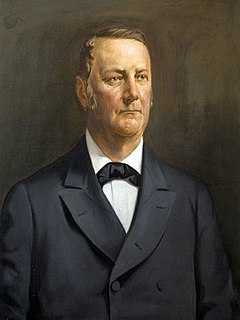
John Merryman of Baltimore County, Maryland, was arrested in May 1861 and held prisoner in Fort McHenry in Baltimore and was the petitioner in the case "Ex parte Merryman" which was one of the best known habeas corpus cases of the American Civil War (1861–1865). Merryman was arrested for his involvement in the mob in Baltimore, specifically for his leadership in the destruction of telegraph lines, but was not charged, a right normally ensured by the writ of habeas corpus. The case was taken up by the federal circuit court and its current presiding judge who happened to be Chief Justice Roger B. Taney, a Democrat-leaning Marylander.
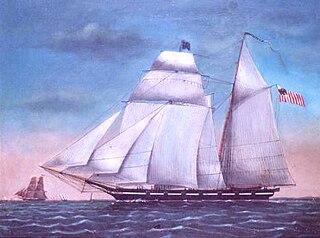
The United States Revenue Cutter Taney was one of the 13 cutters of the Morris-Taney class. These cutters were the backbone of the Revenue Cutter Service for more than a decade. Samuel Humphreys designed these cutters for roles as diverse as fighting pirates, privateers, combating smugglers and operating with naval forces. He designed the vessels on a naval schooner concept. They had Baltimore Clipper lines. The vessels built by Webb and Allen, designed by Isaac Webb, resembled Humphreys' but had one less port.

Laura Gardin Fraser was an American sculptor and the wife of sculptor James Earle Fraser.

William Henry Rinehart was a noted American sculptor. He is considered "the last important American sculptor to work in the classical style."
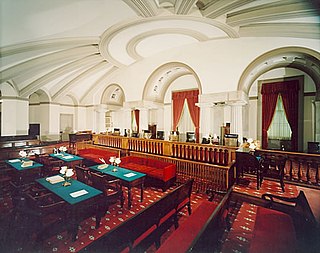
The Old Supreme Court Chamber is the room on the ground floor of the North Wing of the United States Capitol. From 1800 to 1806, the room was the lower half of the first United States Senate chamber, and from 1810 to 1860, the courtroom for the Supreme Court of the United States.
Taney may refer to:

The Taney Court refers to the Supreme Court of the United States from 1836 to 1864, when Roger Taney served as the fifth Chief Justice of the United States. Taney succeeded John Marshall as Chief Justice after Marshall's death in 1835. Taney served as Chief Justice until his death in 1864, at which point Salmon P. Chase took office. Taney had been an important member of Andrew Jackson's administration, an advocate of Jacksonian democracy, and had played a major role in the Bank War, during which Taney wrote a memo questioning the Supreme Court's power of judicial review. However, the Taney Court did not strongly break from the decisions and precedents of the Marshall Court, as it continued to uphold a strong federal government with an independent judiciary. Most of the Taney Court's holdings are overshadowed by the decision in Dred Scott v. Sandford, in which the court ruled that African-Americans could not be citizens. However, the Taney Court's decisions regarding economic issues and separation of powers set important precedents, and the Taney Court has been lauded for its ability to adapt regulatory law to a country undergoing remarkable technological and economic progress.

Roger Brooke Taney was the fifth chief justice of the United States, holding that office from 1836 until his death in 1864. He delivered the majority opinion in Dred Scott v. Sandford (1857), ruling that African Americans could not be considered U.S. citizens and that Congress could not prohibit slavery in the U.S. territories. Prior to joining the U.S. Supreme Court, Taney served as the U.S. Attorney General and U.S. Secretary of the Treasury under President Andrew Jackson. He was the first Catholic to serve on the Supreme Court.

Roger B. Taney is a 19th-century bronze statue of Chief Justice of the United States Roger B. Taney (1777–1864), by William Henry Rinehart. It was located in Baltimore, Maryland at the North Garden in Mount Vernon Place prior to being removed by the city of Baltimore in 2017.
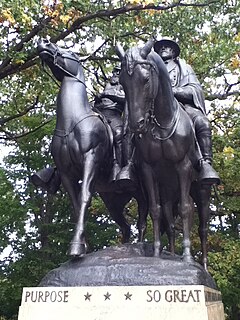
The Stonewall Jackson and Robert E. Lee Monument, often referred to simply as the Jackson and Lee Monument or Lee and Jackson Monument, was a double equestrian statue of Confederate generals Stonewall Jackson and Robert E. Lee, formerly located on the west side of the Wyman Park Dell in Charles Village in Baltimore, Maryland, alongside a forested hill, similar to the topography of Chancellorsville, Virginia, where Stonewall Jackson and Robert E. Lee met before the Battle of Chancellorsville in 1863. The statue was removed on August 16, 2017, on the order of Baltimore City Council, but the base still remains. The monument is in storage and some city council members have called for all Confederate monuments in the state to be destroyed.

The Confederate Soldiers and Sailors Monument was a monument in Baltimore, Maryland, installed in 1903 and removed in 2017.
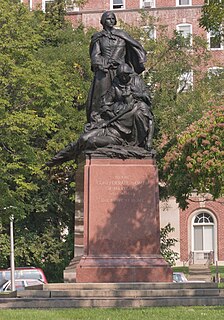
The Confederate Women's Monument was an outdoor memorial by J. Maxwell Miller, installed in Baltimore, in the U.S. state of Maryland in 1917.
The Roger B. Taney Monument is a statue of Roger B. Taney (1777–1864), who was the fifth Chief Justice of the Supreme Court, installed in Annapolis, Maryland, on the State House grounds. The sculpture, by the artist William Henry Rinehart, was unveiled on December 10, 1872. The sculpture, made of bronze, was commissioned by the Legislature of Maryland.
The Tenth Circuit Act of 1863 was a federal statute which increased the size of the Supreme Court of the United States from nine justices to ten, and which also reorganized the circuit courts of the federal judiciary. The newly created Tenth Circuit consisted of California and Oregon, and addressed the judicial needs of the newly created western states. The Act became effective on March 3, 1863, during the Lincoln administration.
Be it enacted by the Senate and House of Representatives of the United States of America in Congress assembled, That the supreme court of the United States shall hereafter consist of a chief justice and nine associate justices, any six of whom shall constitute a quorum; and for this purpose there shall be appointed one additional associate justice of said court, with the like powers, and to take the same oaths, perform the same duties, and be entitled to the same salary, as the other associate justices.
SS Roger B. Taney was a Liberty ship built in the United States during World War II. She was named after Roger B. Taney, who was the fifth Chief Justice of the Supreme Court, holding that office from 1836 until his death in 1864. Prior to joining the Supreme Court, Taney served as the United States Attorney General and United States Secretary of the Treasury under President Andrew Jackson.

Horatio Stone, was an American sculptor, physician and writer. He is best remembered for his three statues in the U.S. Capitol.